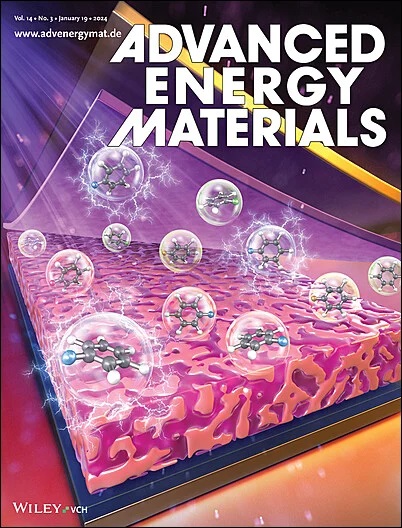通过协同优化非富勒烯受体中的扩展端帽基团和氟化喹喔啉中心核实现高效稳定的有机太阳能电池
IF 24.4
1区 材料科学
Q1 CHEMISTRY, PHYSICAL
引用次数: 0
摘要
分子堆叠行为对有机太阳能电池(OSC)的共混膜形态有重大影响,并进一步影响设备的性能和稳定性。分子结构(如中心单元和末端基团)的改变会对这一过程产生深远影响。本文合成了四种基于喹喔啉(Qx)融合核的非富勒烯受体(NFAs)、Qx-N4F 和 Qx-o/m/p-N4F,并结合了 π 扩展端基和优化的中心单元。氟化异构中心单元导致局部偶极矩和静电位分布发生变化,从而影响了 NFA 的分子堆叠模式和光电子特性。因此,基于 PM6:Qx-p-N4F 的二元和三元器件的功率转换效率(PCE)分别高达 18.75% 和 19.48%。凝胶沉积广角 X 射线散射(GIWAXS)表征显示,Qx-p-N4F 具有更强的结晶性、聚集性和供体-受体相互作用,在保持更多供体-受体界面的基础上,通过更高的相纯度和更紧密的分子堆积,可分别提高短路电流密度(JSC)和填充因子(FF)。此外,基于 PM6:Qx-p-N4F 的器件还表现出卓越的热稳定性,在加热 3000 小时后仍能保持 93.2% 的初始 PCE 值,这得益于最稳定的堆叠结构和最佳的形态稳定性。这些结果凸显了通过共轭扩展和卤化取代协同优化 NFA 对于获得高效稳定的 OSC 的重要意义。本文章由计算机程序翻译,如有差异,请以英文原文为准。

Efficient and Stable Organic Solar Cells Achieved by Synergistic Optimization of Extended End-Capped Groups and Fluorinated Quinoxaline Central Cores in Nonfullerene Acceptors
Molecular stacking behavior exerts a significant influence on the blend film morphology of organic solar cells (OSCs), further affecting device performance and stability. Modulation of the molecular structure, such as central unit and end-group, can profoundly impact this process. Herein, four quinoxaline (Qx)-fused-core-based non-fullerene acceptors (NFAs), Qx-N4F and Qx-o/m/p-N4F are synthesized combining π-extended end-groups and optimized central units. The isomeric fluorinated central units lead to changes in the local dipole moments and electrostatic potential distribution, which influences the molecular stacking pattern and photoelectronic properties of NFAs. Consequently, binary and ternary devices based on PM6:Qx-p-N4F achieve superior power conversion efficiencies (PCE) of up to 18.75% and 19.48%, respectively. Grazing-incidence wide-angle X-ray scattering (GIWAXS) characterization reveals Qx-p-N4F's stronger crystallinity, aggregation, and donor–acceptor interactions, which can separately enhance short-circuit current density (JSC) and fill factor (FF) through higher phase purity and tighter molecular stacking based on maintaining more donor–acceptor interfaces. Furthermore, PM6:Qx-p-N4F-based devices demonstrate exceptional thermal stability, retaining 93.2% of the initial PCE value after 3000 h of heating due to the best morphological stability with the most stable stacking structure. These results underscore the significance of synergistic optimization of NFAs through conjugation expansion and halogenation substitution for obtaining efficient and stable OSCs.
求助全文
通过发布文献求助,成功后即可免费获取论文全文。
去求助
来源期刊

Advanced Energy Materials
CHEMISTRY, PHYSICAL-ENERGY & FUELS
CiteScore
41.90
自引率
4.00%
发文量
889
审稿时长
1.4 months
期刊介绍:
Established in 2011, Advanced Energy Materials is an international, interdisciplinary, English-language journal that focuses on materials used in energy harvesting, conversion, and storage. It is regarded as a top-quality journal alongside Advanced Materials, Advanced Functional Materials, and Small.
With a 2022 Impact Factor of 27.8, Advanced Energy Materials is considered a prime source for the best energy-related research. The journal covers a wide range of topics in energy-related research, including organic and inorganic photovoltaics, batteries and supercapacitors, fuel cells, hydrogen generation and storage, thermoelectrics, water splitting and photocatalysis, solar fuels and thermosolar power, magnetocalorics, and piezoelectronics.
The readership of Advanced Energy Materials includes materials scientists, chemists, physicists, and engineers in both academia and industry. The journal is indexed in various databases and collections, such as Advanced Technologies & Aerospace Database, FIZ Karlsruhe, INSPEC (IET), Science Citation Index Expanded, Technology Collection, and Web of Science, among others.
 求助内容:
求助内容: 应助结果提醒方式:
应助结果提醒方式:


